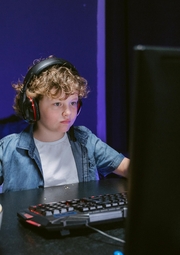The Basics of Webcam Security and Protection
Children are easy targets for cybercriminals and similar people. Children can often be often reckless about their actions. They can click unknown links out of curiosity, only to be taken to an unknown website, or reply to a new message from an unknown addresser. Using a webcam by children also needs special attention from their parents’ side.
Otherwise, children can be unpleasantly surprised or even traumatized—the question of why cybercriminals do this is a conversation for another day. The main point of this content is to explore how you can secure the webcam your children use and prevent any possible negative consequences.
Security First for Webcam Protection
This is the foremost point that has to be ensured. If your device lacks effective protective software, it becomes automatically vulnerable to webcam hackers. This software is a moderate investment ensuring the effective operation of your PC, preventing malware, viruses, or unknowingly given access to accounts and computer data in general. Install that software and explain to your children that it’s for their protection. Parental controls exist to block harmful content, but it won’t stop a data breach or cyber attacks. Antivirus and anti-malware programs are needed.
Make Sure WiFi Is Secured
Sometimes the easiest way to secure your webcam is to protect the entire WiFi network you are using. It is necessary to apply secured and complex passwords for your home network. Your children should also be aware of all risks related to accessing public WiFi networks. If they join such networks, it is easy for computers to become infected by malicious software or become a target for scammers.
To protect children from this risk, you can install VPN software. It secures your devices by changing their real IP addresses. As an outcome, devices remain untraceable.
Secure Smart Technology in the Home
Camfecting is occurring now more than ever. It occurs when a cybercriminal takes remote control of a camera. It’s very common for smart devices such as televisions, phones, baby monitors, and doorbells to have micro-sized digital cameras built in them.
Cybercriminals can use a special type of malware called Remote Access Trojans, or RATs, to gain access to cameras, computer files, and the ability to record keystrokes performed by the user.
One method of infiltrating a camera is done by exploiting known vulnerabilities within the device’s software. Passwords need to be strong for your WiFi and each smart device. Appliances should not be on the same network as your personal computers. Smart TV’s have their own set of privacy settings to be mindful off.
Devices need to be updated regularly so that patches can remediate the vulnerabilities.
Best Practices for WebCam Use
Suspicious Links Avoided
This is a simple rule all children must follow. Instruct them to not click links or download anything from unknown sources. This rule prevents getting malware and spyware that infect the computer and enable getting access to a webcam. If something appears to be suspicious, avoiding that is the best solution. If you child needs a download, they should consult with you first.
Teach children how phishing emails or texts from scammers contain links that will give cybercriminals access to your child’s device, as well as others connected on the same network. These emails may also come some friends they know because their friend’s computer may be infected. Check with all senders directly before clicking a link in a message from them.
“Stranger –Danger”
This rule is related to communications with unknown people. Children should not start this communication and share with them any kind of personal information. It is necessary to explain to children that even if these persons are pleasant to deal with, it is unlikely that somebody will ask to share personal information about a person during the first conversations.
What information is usually requested by strangers? It includes the details about the child’s history, date of birth, siblings, information related to parents, etc. Emphasize that your children should not deal with strangers online and provide those any authorizations.
Explain How Web Cams Work
Previous tips are effective, but they only decrease the risks related to hackers attempting to access webcams. You should explain that to your children and also clarify how this device can be compromised. But there is one simple way to they can remain protect themselves. An important rule for everyone, including adults, is to cover the camera eye of any webcam when not using it. It is an easy-to-arrange technique that only requires a sticker or a special case you can purchase to be placed on the camera eye.
Create Rules for the Camera’s Location
The easiest strategy on how to secure children from possible negative consequences while using a webcam is determining strict rules for using it. The most workable rule, in this case, is avoiding using a webcam in a bedroom or bathroom. The situation is simple here. A child may easily forget to switch off the camera. This mistake may have negative consequences, especially if the webcam is regularly used in a private room of a home.
Secure Devices for Your Work from Children
Don’t allow your child to use webcams that are connected to your work. This opens them up to accidentally connecting with fellow employees with the potential to share private information to collogues. The best strategy here is to secure your devices with effective passwords and separate those devices from personal use by other family members.
Secure Data and Cloud Storage
If video or video chats are saved, ensure they are stored securely. You can also look into encryption methods if you like. But most certainly, ensure all data on any computer is safe from outside access. Besides strong passwords for accounts and cloud storage, applying two-factor authentication is vital keep keeping private files from being accessed.
Webcam Red Flags to Pay Attention to
Indicator Light: Most webcams have an indicator light that turns on when the camera is active. If you notice this light is on unexpectedly, it could indicate that your webcam is in use.
Unexplained Activity: If your computer starts behaving strangely, such as windows opening or closing without your input, it could be a sign that someone is remotely accessing your system, including your webcam.
Unexpected Software: If you see new software installed on your computer that you didn’t install yourself, it might be malware or spyware designed to access your webcam.
Firewall Alerts: If your firewall software alerts you to unauthorized attempts to access your webcam, take it as a red flag.
Antivirus Warnings: Some antivirus software may detect suspicious activity related to webcam access and notify you about it. Take these warnings seriously and investigate further.
Check for Remote Access Tools: Regularly check your computer for remote access tools or software that could be used to access your webcam without your knowledge.
Final Words
Cyber threats are always lurking for children and adults alike. Webcams are often forgotten about when we think about the harm can happen on because of their use. These tips on how to secure a webcam can spare your children from the negative consequences that may occur when interacting with others online.
It is always better to explain to your kids that the internet is not simply place full of joyful and interesting stuff. It’s also where cybercriminals and predators exist, and webcams are just one of the means children can be exploited. Vigilance is required to set and follow these personal safety and computer security rules for webcams. As a result, the internet can be a much safer place for fun with friends, as well as enjoy the full benefits for learning.
Author’s Bio
Aston Rhodes is an experienced content creator and marketing expert for https://jatapp.com/. Aston has been helping authors improve their blogs for over 5 years and turn this hobby into a business. She does research and discussion on tech-related topics. She enjoys sharing her experiences with a like-minded audience and writes about software development, digital marketing, business, career, and more.





